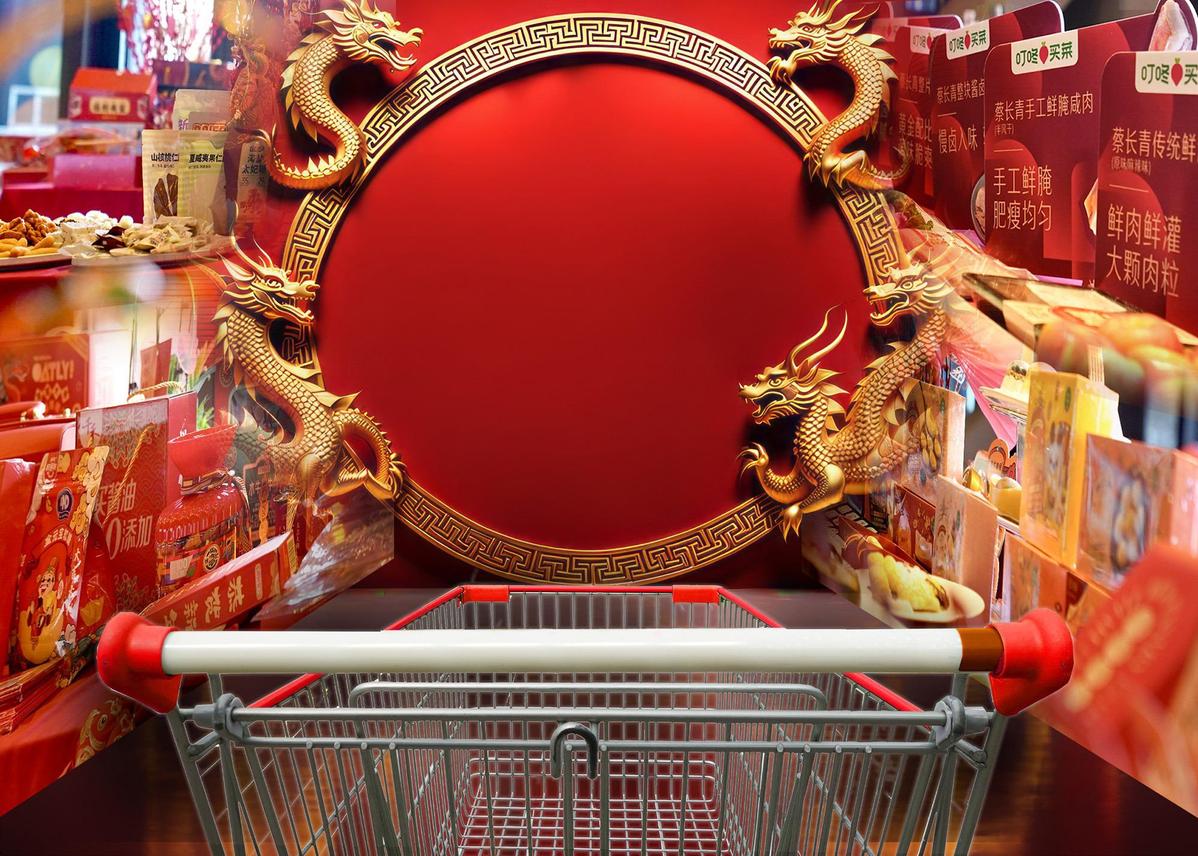Heading north for Lunar New Year
With HK consumers pouring across the border to shop for Spring Festival this year, grocery chains and catering outlets in Shenzhen are upgrading their operations to seize the business opportunities arising from the influx. Zhou Mo reports from Shenzhen.


Jennifer Lau traveled to Shenzhen twice last month, joining droves of bargain hunters from Hong Kong who were on a mission to shop ahead of the upcoming Spring Festival, which falls on Feb 10.
She went with her husband and her mother, carrying a 22-inch (56-centimeter) suitcase to stuff full of their many planned purchases. They first lunched at a Guangdong-style hotpot restaurant in the city's Futian district before taking the metro to Sam's Club to shop.
Lau, 37, who works for a foreign trade company in Hong Kong, would spend about HK$3,000 ($383) on each cross-border trip, including shopping, meals and entertainment, taking cooking oil, snacks, new year gifts and clothing back home.
"I hadn't traveled north until recently because I thought it wouldn't be convenient, with the transport, language and payment problems. However, it turned out to be totally different from what I had expected," she says.
Since the full resumption of normal travel between Hong Kong and the Chinese mainland early last year, there has been a growing number of Hong Kong residents flocking to Shenzhen in the mainland's Guangdong province to dine, shop and for entertainment. With the approach of the Lunar New Year, the trend has been accelerating.
Hong Kong's Immigration Department expects 7.5 million inbound and outbound trips to be made through the city during the holidays heralding the start of the Year of the Dragon, with 6 million trips to be made via land crossings, including Lo Wu, which is expected to be the busiest port.
Seeing a changing consumption landscape from previous years, businesses in Shenzhen are adjusting their strategies this year to take advantage of the holiday spending boom created by the surge in the number of Hong Kong visitors.
"The most significant trend is that the proportion of catering outlets - especially those in the Chinese specialty cuisine and new-style tea drinks subsectors - in a mall's tenant mix has increased significantly to meet the growing dining demand from Hong Kong consumers," says Zhang Xiaoduan, deputy dean of the Cushman & Wakefield Research Institute.
"This is particularly noticeable in mid-range malls near the checkpoints and transit hubs, such as Link CentralWalk and Wongtee Plaza (in the Futian district)."
The expansion of warehouse clubs and grocery chains like Sam's Club, Hema and Costco in Shenzhen has also accelerated, partly to better satisfy the "buy-in-bulk" needs of Hong Kong consumers who travel to the city on the northern side of the border every one or two weeks, says Zhang.
Hema recently upgraded the dining area of its Wongtee Plaza branch - one of its stores nearest to Futian checkpoint - to provide a better experience for Hong Kong customers.
Online grocery platforms are also upgrading their offerings and developing new cuisines to better meet Hong Kong consumers' demand for Lunar New Year dishes, as a growing number of Hong Kong residents are using mainland apps to order fresh food in Shenzhen, pick it up at the checkpoint and take it back to Hong Kong.
According to Chinese online grocery platform Dingdong Fresh, cross-border orders from Hong Kong have increased notably, and are mostly relatively big. "We now receive dozens of orders that have to be delivered to Futian checkpoint each week," says Wen Xianyong, who is in charge of Dingdong Fresh's Fumin store in Futian district.
"Normally, they (Hong Kong buyers) would choose Gate 11 at Futian checkpoint as the pick-up site for delivery. It's convenient for delivery staff to send the food there, and Hong Kong consumers can retrieve the goods easily."
Price is right
Wen notes that their Hong Kong consumers mainly buy high-value commodities. "Our self-developed pre-cooked hotpot products are quite popular. Each order is worth more than 200 yuan ($28)."
The online platform is trying to grasp the business opportunities brought by the ongoing trend. It has introduced various types of poon choi (a mixed stew made with vegetables, meat and seafood) and rice cakes - traditional Chinese New Year dishes - that cater to Hong Kong tastes, and teamed up with more than 10 well-known restaurants and hotels to launch cobranded classic Chinese New Year food gift boxes.
According to Chinese food delivery platform Meituan, nearly 80 percent of Hong Kong consumers feel that mainland food and beverages are the most attractive. The growth rate of takeaway sales of special purchases for the Spring Festival in Guangdong province has soared by 1,200 percent since January, compared with the same period a year ago, with pastries, sauced meat and beef balls being the most sought-after items for Hong Kong consumers, the platform said.
A Hong Kong resident, surnamed Tso, says she buys beef balls every year as a special food item for the Spring Festival. "It normally costs more than HK$60 to buy four beef balls in Hong Kong. But on the mainland, I can buy a half kilogram, or about 21 beef balls, with just HK$50 or so," she says.
The growing demand for mainland commodities from Hong Kong consumers has also given rise to a growing number of daigous - shopping agents making purchases on behalf of customers.
On Chinese social media and lifestyle platform Xiaohongshu, which translates as Little Red Book, an agent said HK$100 will be charged for helping a Hong Kong resident buy items worth between HK$200 and HK$500 at Sam's Club in Shenzhen.
For items costing between HK$500 and HK$1,000, a fee of HK$180 will be charged. A deposit amounting to 50 percent of the items' value must be made before the face-to-face transaction takes place between buyer and agent at or near a Hong Kong metro station.
"Hong Kong consumers get information on the Shenzhen retail market mainly from social media platforms like Xiaohongshu," says Chen Wenhui, retail head of advisory and transaction services at CBRE Southern China.
"The consumption boom has enabled Shenzhen merchants to understand the consumption characteristics of Hong Kong residents, which will boost the confidence of mainland brands in opening up new stores in the special administrative region," says Chen.
The closer interaction between the two cities, both online and offline, allows Hong Kong consumers to gain a deeper understanding of the mainland's economic and cultural environment, helping the SAR to better integrate into the country's overall development, he adds.
While the influx of Hong Kong spenders has created tremendous business opportunities for businesses in Shenzhen, there are also challenges, given the differences in preferences and spending habits between them and local people.
For Hong Kong consumers, well-established brands and reliable products are preferred. In comparison, their Shenzhen counterparts tend to like curiosities, and go for new and unique products and brands, says Zhang.
"Retailers face the permanent challenge of maintaining brand popularity while ensuring high-quality and freshness," she says.
"In addition, cash payments are rare among locals (Shenzhen residents usually make online settlements), while for Hong Kong people, cash is still their customary payment method. Retaining a cash payment option is essential for (businesses to attract) both tourists and local customers who aren't familiar with using the mainland's e-payment platforms, such as the elderly and children."
Contact the writer at sally@chinadailyhk.com
- China's Yunnan launches cultural exhibition in Saudi capital, spotlighting heritage, tourism ties
- Yueyang China Panda Garden welcomes summer with 10 playful giant pandas
- Global scientists convene in Beijing for Earth modeling hackathon
- Chinese researchers build high-precision topographic dataset for Chang'e 6 landing area
- China's rose industry takes center stage at international horticultural event
- 2025 Shanghai Education Expo to spotlight integration of AI in education





































